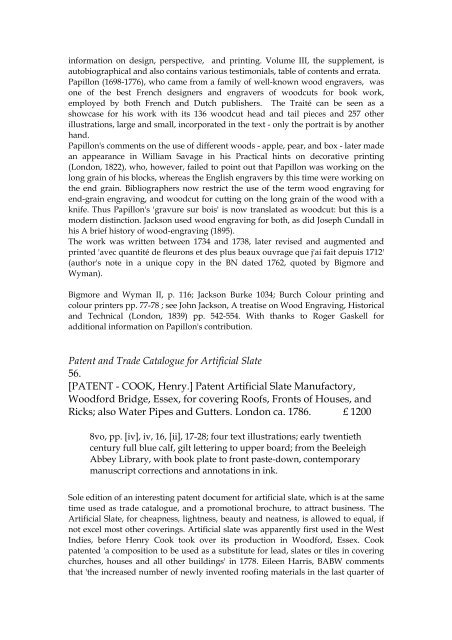«Merge Record #»«Title» - Schulz-Falster Rare Books
«Merge Record #»«Title» - Schulz-Falster Rare Books
«Merge Record #»«Title» - Schulz-Falster Rare Books
You also want an ePaper? Increase the reach of your titles
YUMPU automatically turns print PDFs into web optimized ePapers that Google loves.
information on design, perspective, and printing. Volume III, the supplement, is<br />
autobiographical and also contains various testimonials, table of contents and errata.<br />
Papillon (1698-1776), who came from a family of well-known wood engravers, was<br />
one of the best French designers and engravers of woodcuts for book work,<br />
employed by both French and Dutch publishers. The Traité can be seen as a<br />
showcase for his work with its 136 woodcut head and tail pieces and 257 other<br />
illustrations, large and small, incorporated in the text - only the portrait is by another<br />
hand.<br />
Papillon's comments on the use of different woods - apple, pear, and box - later made<br />
an appearance in William Savage in his Practical hints on decorative printing<br />
(London, 1822), who, however, failed to point out that Papillon was working on the<br />
long grain of his blocks, whereas the English engravers by this time were working on<br />
the end grain. Bibliographers now restrict the use of the term wood engraving for<br />
end-grain engraving, and woodcut for cutting on the long grain of the wood with a<br />
knife. Thus Papillon's 'gravure sur bois' is now translated as woodcut: but this is a<br />
modern distinction. Jackson used wood engraving for both, as did Joseph Cundall in<br />
his A brief history of wood-engraving (1895).<br />
The work was written between 1734 and 1738, later revised and augmented and<br />
printed 'avec quantité de fleurons et des plus beaux ouvrage que j'ai fait depuis 1712'<br />
(author's note in a unique copy in the BN dated 1762, quoted by Bigmore and<br />
Wyman).<br />
Bigmore and Wyman II, p. 116; Jackson Burke 1034; Burch Colour printing and<br />
colour printers pp. 77-78 ; see John Jackson, A treatise on Wood Engraving, Historical<br />
and Technical (London, 1839) pp. 542-554. With thanks to Roger Gaskell for<br />
additional information on Papillon's contribution.<br />
Patent and Trade Catalogue for Artificial Slate<br />
56.<br />
[PATENT - COOK, Henry.] Patent Artificial Slate Manufactory,<br />
Woodford Bridge, Essex, for covering Roofs, Fronts of Houses, and<br />
Ricks; also Water Pipes and Gutters. London ca. 1786. £ 1200<br />
8vo, pp. [iv], iv, 16, [ii], 17-28; four text illustrations; early twentieth<br />
century full blue calf, gilt lettering to upper board; from the Beeleigh<br />
Abbey Library, with book plate to front paste-down, contemporary<br />
manuscript corrections and annotations in ink.<br />
Sole edition of an interesting patent document for artificial slate, which is at the same<br />
time used as trade catalogue, and a promotional brochure, to attract business. 'The<br />
Artificial Slate, for cheapness, lightness, beauty and neatness, is allowed to equal, if<br />
not excel most other coverings. Artificial slate was apparently first used in the West<br />
Indies, before Henry Cook took over its production in Woodford, Essex. Cook<br />
patented 'a composition to be used as a substitute for lead, slates or tiles in covering<br />
churches, houses and all other buildings' in 1778. Eileen Harris, BABW comments<br />
that 'the increased number of newly invented roofing materials in the last quarter of
















